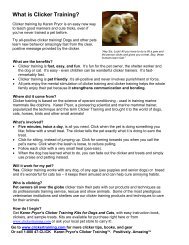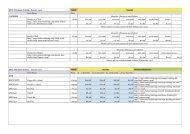with Your Rabbit - Clicker Training
with Your Rabbit - Clicker Training
with Your Rabbit - Clicker Training
- No tags were found...
Create successful ePaper yourself
Turn your PDF publications into a flip-book with our unique Google optimized e-Paper software.
AKaren PryorGetting Started:<strong>Clicker</strong>Book<strong>with</strong> <strong>Your</strong> <strong>Rabbit</strong>Joan OrrandTeresa Lewin
Photo credits:B.U.N.S, Bunnies Urgently Needing Shelter, Santa Clara Humane Society, California:1, 3, 7, 11, 15, 17, 21, 25, 30, 31, 35, 39, 49, 64 a and b, 71, 78Joan Orr: Front cover, 4, 20, 23, 36, 38, 43, 53, 55, 57, 70Theresa Lewin: 44, 46, 51Other titles in this seriesGetting Started: <strong>Clicker</strong> <strong>Training</strong> for Dogs by Karen PryorGetting Started: <strong>Clicker</strong> <strong>Training</strong> for Cats by Karen PryorGetting Started: <strong>Clicker</strong> <strong>Training</strong> for Horses by Alexandra KurlandGetting Started: <strong>Clicker</strong> <strong>Training</strong> for Birds by Melinda JohnsonGetting Started: Clicking <strong>with</strong> <strong>Your</strong> <strong>Rabbit</strong>© 2006 Joan Orr and Teresa LewinAll rights reserved. No part of this book may be reproduced or transmitted in any formor by any means, electronic or mechanical, including photocopying, recording, or by anyinformation storage or retrieval system, <strong>with</strong>out permission in writing from the publisher.For information contact:Sunshine Books, Inc.49 River StreetWaltham, MA 02453781-398-0654www.clickertraining.comLibrary of Congress Control Number 2006924593ISBN 1-890948-21-7Book design by Codesign, BostonPrinted in the United States of America10 9 8 7 6 5 4 3 2 1
AKaren Pryor<strong>Clicker</strong>Book
ivGetting Started: Clicking <strong>with</strong> <strong>Your</strong> <strong>Rabbit</strong>
Contents1. What? Train a <strong>Rabbit</strong>? 1<strong>Clicker</strong> <strong>Training</strong> Defined 2<strong>Clicker</strong> <strong>Training</strong> Works 5Anyone Can Train a <strong>Rabbit</strong> 6All <strong>Rabbit</strong>s Can Be Trained 62. Getting Started 9Tools of the Trade 9The <strong>Clicker</strong> 10Treats 10Props for Tricks 14The <strong>Training</strong> Area 14Introducing the <strong>Clicker</strong> 16Get the Behavior 19Capture a Natural Behavior 19Lure <strong>with</strong> Food 19Follow a Target 20Shaping 20Click! 22Reward the Behavior 22Add a Cue 23Fade the <strong>Clicker</strong> and Treats 25v
3. Ready, Set, Go! ... <strong>Your</strong> First Trick 29Basic Target <strong>Training</strong> 29Frequently Asked Questions 324. What Should I Teach? 35Choosing Suitable Tricks 36Guidelines for <strong>Training</strong> 37General Guidelines 37Manipulating the Environment 38<strong>Training</strong> Outline 40Keep It Fun! 425. Fun Tricks to Teach <strong>Your</strong> <strong>Rabbit</strong> 43Stand on Hind Legs (or Sit Pretty) 44“Gimme Ten” 45“Gimme Five” 46Sit in a Basket 47Jump 49Spin 50Goal! 51Putting Tricks Together 526. Useful Tricks 55Come When Called 56Go Home 57Litter Box <strong>Training</strong> 59Cage Cleaning 62Nail Clipping 64Grooming 66Handling and Veterinary Care 67viGetting Started: Clicking <strong>with</strong> <strong>Your</strong> <strong>Rabbit</strong>
7. Solving Problem Behavior 69Frequently Asked Questions 788. Where to Learn More 79Improving <strong>Your</strong> <strong>Clicker</strong> Timing and Technique 79<strong>Clicker</strong> <strong>Training</strong> Information and Gear 80Information about <strong>Rabbit</strong> Care 80<strong>Clicker</strong> <strong>Training</strong> Discussion Lists 81vii
CHAPTER 1What? Train a <strong>Rabbit</strong>?<strong>Rabbit</strong>s … furry and lovable, of course; quirky and silly, sometimes;full of energy and mischief, undoubtedly. But trainable?You bet! You’re probably training your rabbit <strong>with</strong>out evenrealizing it. Is he litter box trained? Does he come to see youwhen you go to his cage? Then you’ve already taken your firststeps toward training.There’s so much more yourrabbit can learn! Have you everseen a rabbit fetch? Or playbasketball? (<strong>Rabbit</strong>-sized, ofcourse.) What about navigatinga course of jumps and tunnels?These are all tricks you canteach your pet bunny. You canalso teach him some tricks tomake your life together easier.How would you like it if your What! Train a rabbit? Of course you can!rabbit sat still while youtrimmed his nails or came when you called his name? All ittakes is a little training.<strong>Training</strong> is actually good for your rabbit. When it is allpositive—rewards only and no punishment—training can replacemany of the activities and thinking that rabbits do naturally inChapter 1: What? Train a <strong>Rabbit</strong>? 1
the wild. Finding food, creating homes, and staying safe allrequire various activities and problem solving; most of thesethings are not required of a pet living in a cage or a humanhouse. <strong>Training</strong> sessions provide your pet <strong>with</strong> mental andphysical stimulation, and allow him to use his natural abilities.This will contribute to a longer and happier life for your rabbit.Many rabbits languish in their cages most of their lives, butyour trained bunny will delight you <strong>with</strong> tricks and antics. Youwill be eager to take him out of his cage and explore furtherpossibilities—and he will be eager to explore them <strong>with</strong> you.This positive method of training is popularly known asclicker training, and it is a great way to teach your rabbit allsorts of things. <strong>Clicker</strong> training is fun for both you and yourbunny and helps to strengthen the bond between you.According to clicker training pioneer Karen Pryor, “Clicking<strong>with</strong> rabbits brightens their lives, exercises their surprisinglylively minds, and brings out their endearing personalities.They’ll love training you to click and treat! It’s easy to learn, andmentally and physically enriching for pets and their owners.”CLICKER TRAINING DEFINEDWhat exactly is clicker training? It is a teaching system inwhich a click sound is used to tell the rabbit he has done theright thing. The click sound is made by using a small, handhelddevice that clicks when pressed. The sound the clicker makeswhen you press it tells your rabbit, “Yes! That’s right!” The clickis always followed closely <strong>with</strong> a food treat so that your petcomes to associate the click <strong>with</strong> something good. Soon therabbit wants to hear the click sound. This is because he knowsa treat will follow and this makes him feel happy and secure.2Getting Started: Clicking <strong>with</strong> <strong>Your</strong> <strong>Rabbit</strong>
<strong>Clicker</strong> training teaches thebunny that he can cause youto click, and then give him atreat, through his own actions.Let’s say, for example, that youclick and treat each time hecomes toward you in his cage.Soon he will actively try to getyou to click by coming towardyou when you come near thecage. Next you will be able toadd a verbal cue (a command)and your bunny will start comingto you when you call. “It’svery exciting to see an animalexperience the ‘Aha!’ moment when he suddenly realizesthat he can actively control the clicker game,” said Pryor.When the rabbit hears the click soundhe knows a treat will follow, whichmakes him feel happy and secure.Any treat that you can give to your rabbit that he desiresand that motivates him to repeat a behavior is called areinforcer. A treat can be food, petting, freedom, or a chanceto play <strong>with</strong> a favorite toy. Food treats are the strongestreinforcers for most rabbits, and we recommend that youbegin training your rabbit <strong>with</strong> food treats.In clicker training, you influence a pet’s behavior in twoways. The first is positive reinforcement, in which you rewardyour pet <strong>with</strong> a click and treat when he does something youlike and want him to do again. The other way you influencebehavior is simply to ignore behavior that you don’t like.Behavior that is reinforced will become stronger; behavior thatis ignored tends to fade away. Punishment, scolding, or physicalcorrection are not used in clicker training.Chapter 1: What? Train a <strong>Rabbit</strong>? 3
CLICKER TRAINING BASICSIn clicker training, you:• Reward desired behavior• Ignore unwanted behavior• Do not use punishment, scolding, or physical correctionYou may be wondering, “Why do I need the clicker? Whycan’t I just give my rabbit a treat <strong>with</strong>out the click sound?Why can’t I just say ‘good boy’ to my bunny rather than clicking?”We click because the sound is clear, consistent, and precise.A word can be spoken in different ways. An animal may notrecognize the same word if spoken in a different tone. The rabbitknows that the click means a treat is coming, every time.A click can be made at exactly the same time the animaldoes the behavior we want to reward. It is difficult to say aword at precisely the same moment as the behavior; usually aspoken word comes a moment later. When the click occursat the same instant as thebehavior, the rabbit knowsexactly what he did to deservea treat. It is not usually possibleto deliver a treat exactlyat the same time a behavioroccurs, especially if your rabbitis in a cage or across the roomfrom you.The click lets you “mark”the desired behavior exactly,Angel gets clicks and treats for exploringher new play house.4Getting Started: Clicking <strong>with</strong> <strong>Your</strong> <strong>Rabbit</strong>
telling your rabbit: “This is what you are doing that will earnyou a treat.” If you simply give a treat, the rabbit may havedone several other behaviors by the time he actually receivesthe treat. He may then be confused about which behavioror which aspect of the behavior resulted in the treat, andtherefore will not know what behavior to repeat in order toearn another treat.For example, perhaps you are trying to teach your bunnyto come to the door of the cage. He has done so, but by thetime you open the door to give the food reward, the bunny hasalready become frustrated and started chewing on the door.You give the treat because the bunny came to the door, but heassociates the reward <strong>with</strong> chewing on the door. You may haveinadvertently taught your rabbit to chew on his cage doorto get a treat. If you use the clicker to instantly “mark” theappropriate behavior of coming to the door, then he will learnthat the correct behavior is to come to the door of the cage.You will be amazed by how smart your bunny is! All he needsis to be able to communicate effectively <strong>with</strong> you, and you<strong>with</strong> him. The clicker makes this possible.CLICKER TRAINING WORKSThere are hundreds of thousands of clicker trainers aroundthe world, training almost every conceivable captive species.Why? Because clicker training works! It works <strong>with</strong> dolphinsand birds that you’ve seen in trained animal shows. It works<strong>with</strong> search-and-rescue dogs. It works <strong>with</strong> elephants andtigers, and even <strong>with</strong> turtles and fish.<strong>Clicker</strong> training is also making a difference in the lives ofshelter animals waiting for adoption. Many animal sheltershave begun clicker training <strong>with</strong> their rabbits, dogs, and ferrets.Chapter 1: What? Train a <strong>Rabbit</strong>? 5
Andrea Bratt Frick and Jean Silva of B.U.N.S. (BunniesUrgently Needing Shelter) in California have been clickertraining shelter rabbits to enrich their lives and make themmore adoptable. Jean Silva says, “Once you get started andlearn how to use the clicker, you and your rabbit become‘hooked.’ It is simple to use, and the results are so powerful!We have been using the clicker to get all our bunnies to cometo the front of their cages to appear friendly to help thembecome more adoptable. Also, we have taught them little trickssuch as ‘Gimme Ten’ so that the bunnies (who were fearful atfirst) would interact <strong>with</strong> potential adopters.”Anyone Can Train a <strong>Rabbit</strong>Who are all these clicker trainers? They are people just likeyou. Some are adults, some are kids, some are professionaltrainers, and some are shelter volunteers. Anyone who canpress a clicker and give a pet a treat can clicker train.Sometimes beginners train in teams, <strong>with</strong> one person clickingand the other treating. This is a good way for new clickertrainers to learn because one person focuses on handling theanimal and pressing the clicker, and the other on deliveringthe treat quickly.All <strong>Rabbit</strong>s Can Be TrainedWe have yet to encounter a rabbit that cannot be clickertrained. Some rabbits learn more quickly, some will work forlonger periods, and some get bored easily. Any rabbit that canbe motivated by something you have that he wants can beclicker trained. Sometimes it takes a bunny a few sessions toget used to the sound of the clicker or to associate the click<strong>with</strong> the treat. Some pets catch on right away. We have trained6Getting Started: Clicking <strong>with</strong> <strong>Your</strong> <strong>Rabbit</strong>
many rabbits, and even <strong>with</strong>in this one species there is awide range of ability when it comes to learning new things.The key to success <strong>with</strong> clicker training a rabbit is tounderstand your rabbit. Observe to see what he likes to eat,what kinds of behaviors he does naturally, and what kind ofenvironment he prefers. Consult the resources listed inChapter 8 (see page 79) to find out what others have observedabout rabbits. You will want to know what type of home yourrabbit likes, what toys and activities he prefers, how to keephim healthy, and what kinds of treats you can use for training.A wonderful aspect of clicker training your bunny is the timethat you spend observing and playing <strong>with</strong> him. Once youunderstand what makes your bunny tick you can set up yourtraining sessions to ensure success.Bunnies can learn a lot! This clicker-trained bunny has learned to “weave” through a lineof “carrot sticks” the way agility-trained dogs go through the weave pole obstacle.Chapter 1: What? Train a <strong>Rabbit</strong>? 7





